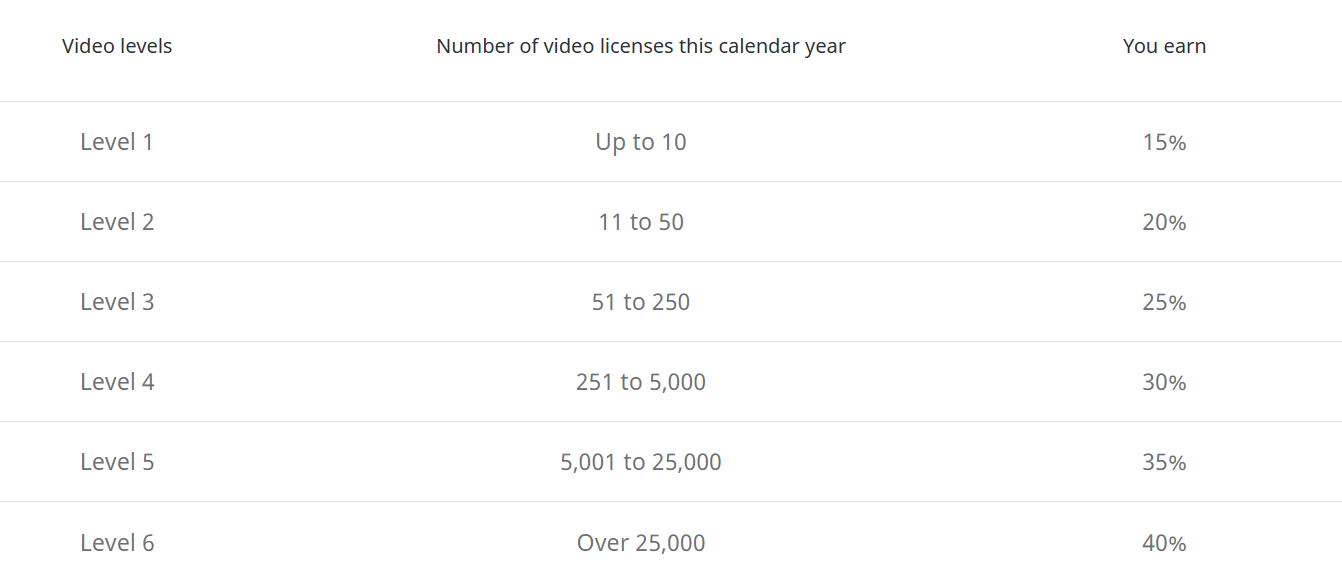If you’re diving into the world of stock videos, you’ve probably wondered, “How much can I really make from my videos on Shutterstock?” The truth is, earnings can vary quite a bit based on various factors, but understanding the basics can help you set realistic expectations and optimize your content for better income. Shutterstock is one of the leading platforms for stock footage, offering creators a chance to monetize their work while reaching a global audience. Whether you’re a seasoned videographer or just starting out, knowing how earnings are calculated can make a big difference in your creative journey.
Factors Influencing Your Income Per Video
Your earnings from each video on Shutterstock aren’t set in stone—they depend on several key elements. Let’s break down the most important factors that can influence how much you make per video:
1. Video Quality and Resolution
High-quality, professional-looking videos tend to earn more because they meet the platform’s standards and appeal to a broader range of buyers. Uploaded videos in 4K resolution generally fetch higher royalties compared to lower resolutions. Invest in good equipment and editing techniques to produce crisp, clear footage that stands out.
2. Content Niche and Demand
Some niches are more popular than others. For example, videos related to business, technology, health, and lifestyle often sell better because they are in higher demand. Conversely, more niche or specialized content might not sell as often but can command higher prices per download. Keeping an eye on trending topics and popular categories can help you create content with better earning potential.
3. Licensing Type and Usage
Shutterstock offers different licensing options—Standard and Extended. Standard licenses are more common and generate standard royalties, while Extended licenses are purchased for broader or more intensive use, leading to higher payouts. Additionally, videos used in commercial projects or advertising tend to earn more than those used for personal projects.
4. Video Views and Downloads
The more your videos are viewed and downloaded, the more you earn. While Shutterstock pays royalties based on the type of license and your contributor status, increasing your video’s visibility can boost your income. Promoting your portfolio and tagging videos effectively can help attract more buyers.
5. Contributor Level and Portfolio Size
Shutterstock rewards active contributors with higher royalty rates as they upload more content and maintain quality standards. Building a sizable, diverse portfolio increases your chances of earning more per video, especially if your videos are consistently popular.
6. Geographic Market
Different regions have different purchasing power and demand. Videos that appeal to international audiences or are relevant across multiple markets can generate more income. Localization, such as adding subtitles or captions, can also help expand your reach.
In summary, your earnings per video depend on a mixture of quality, relevance, licensing, and market factors. By paying attention to these elements and continuously improving your craft, you can maximize your earning potential on Shutterstock. Remember, success often comes with patience and persistence—so keep creating and refining your videos!
How Shutterstock Pays Creators for Video Content
So, you’ve uploaded some fantastic videos to Shutterstock and are eager to understand how you’ll get paid. Let’s break down the process in a straightforward way. Shutterstock uses a royalty-based system, meaning you earn a percentage of the revenue generated whenever someone licenses your video.
Here’s the basic idea: when a user purchases a license for your video, Shutterstock credits your account with earnings based on your creator level and the type of license sold. The platform offers different licensing options—standard and enhanced—each with its own payout structure.
How does the payout work?
- Royalty Rates: Shutterstock pays creators a percentage of each sale, which can range from about 20% to 30% depending on your contributor level and sales volume.
- Earnings Per License: Typically, a standard license might net you around $0.25 to $0.50 per download, but this varies widely based on factors like video length, quality, and licensing type.
- Payment Threshold: You need to reach a minimum earning amount—usually $35—before you can withdraw your earnings.
Once you hit that threshold, Shutterstock processes your payment via PayPal or bank transfer, usually once a month. It’s pretty straightforward, but it’s important to understand that your earnings depend heavily on how many times your videos are licensed and the licensing type.
Another thing to keep in mind is that Shutterstock’s payout structure rewards volume. The more videos you upload and license, the more your potential earnings grow. Plus, as your contributor level increases, so does your royalty rate, giving you an incentive to produce even better content.
Estimating Your Earnings Based on Video Type and Quality
Wondering how much you can actually make? Well, it’s a mix of several factors—video type, quality, licensing, and demand. Let’s walk through how these elements influence your earnings and how you can get a rough estimate.
First, consider the video type. Some categories are more popular than others. For example:
- Business and Corporate: Often used for promotional videos, these tend to fetch higher licensing fees.
- Nature and Outdoors: Popular among travel and lifestyle brands, but licensing rates can vary.
- People and Lifestyle: In high demand, especially if featuring diverse, authentic scenarios.
Next, think about video quality. High-resolution, well-lit, and professionally edited videos are more likely to be licensed multiple times. Think of your videos as products—better quality increases their appeal and licensing potential.
To give you a rough idea, here’s a simplified table to estimate earnings based on video type and licenses sold:
| Video Type | Average License Fee | Estimated Earnings per License |
|---|---|---|
| Business/Corporate | $50 – $200 | $10 – $60 (20-30% royalty) |
| Nature & Outdoors | $30 – $150 | $6 – $45 |
| People & Lifestyle | $40 – $180 | $8 – $54 |
So, if your high-quality corporate video gets licensed 10 times at an average of $100 per license, you could earn between $200 and $300 (based on a 20-30% royalty). That’s a pretty decent return for a single video!
How to maximize your earnings? Focus on creating high-demand content, optimize your videos for quality, and keep uploading consistently. Over time, your portfolio grows, and so does your earning potential. Remember, it’s about building a steady stream of licenses rather than relying on a single viral hit.
In summary, estimating your Shutterstock video earnings involves understanding licensing rates, your video quality, and market demand. Keep producing great content, and your earnings can grow steadily over time!
Tips to Maximize Your Video Income on Shutterstock
So, you’re eager to boost your earnings on Shutterstock, huh? Great! The good news is that with a few smart strategies, you can increase your income potential and make your videography efforts truly pay off. Here are some tips to help you get the most out of your Shutterstock videos:
Focus on Popular and Evergreen Topics
Think about creating videos around themes that are always in demand. Things like business, technology, health, lifestyle, and nature tend to perform well consistently. These “evergreen” topics attract steady viewers and can generate ongoing sales over time.
Optimize Your Metadata
Have you heard the saying, “tags are king”? Well, it’s true! Use clear, descriptive, and relevant titles, tags, and descriptions. This helps your videos show up in search results when buyers are looking for specific content. Be specific but avoid keyword stuffing—think about what someone would type if they were searching for your video.
Upload Consistently
Regular uploads keep your portfolio fresh and increase your chances of getting noticed. The more quality videos you have, the higher the chance that buyers will find and purchase your work. Set a manageable schedule—whether it’s weekly or monthly—and stick to it.
Invest in Quality Equipment and Editing
High-quality videos tend to perform better. Invest in good cameras, lighting, and editing software. Sharp visuals, clear audio, and smooth editing make your videos stand out from the crowd. Remember, buyers are often looking for professional-looking content.
Engage with the Shutterstock Community
Participate in forums, comment on other creators’ work, and stay updated on trending topics. Building connections can lead to valuable tips and collaborations. Plus, a good reputation can sometimes lead to more visibility and sales.
Analyze Your Performance
Use Shutterstock’s dashboard to see which videos sell best. Are certain topics or styles performing better? Focus on creating more of what works. Learning from your analytics allows you to refine your content strategy over time.
Offer a Variety of Content
Don’t put all your eggs in one basket. Experiment with different styles, themes, and formats—like drone footage, time-lapses, or animations. The more diverse your portfolio, the broader your appeal to different buyers.
Remember, maximizing your earnings isn’t about quick wins; it’s about consistent effort, quality, and understanding what your audience wants. With patience and persistence, your Shutterstock video income can grow significantly!
Conclusion and Final Thoughts on Earning Potential
Wrapping it all up, earning money with videos on Shutterstock can be a rewarding venture—both creatively and financially. While the exact income varies based on factors like video quality, topic popularity, and your overall portfolio, many creators find that with dedication, they can generate a steady income stream.
It’s important to set realistic expectations. Some videos might earn only a few dollars, while others, especially those that go viral or hit a niche market, can bring in much more. The key is to focus on creating high-quality content, staying consistent, and continuously learning how to improve your work and marketing strategies.
Remember, Shutterstock offers a flexible platform where you can grow your videography skills while earning money at your own pace. Whether you’re just starting out or have an established portfolio, there’s always room to optimize and expand your earnings.
So, keep shooting, stay inspired, and don’t get discouraged by slow days. The potential to turn your passion for videography into a profitable side hustle or even a full-time income is very much within reach. Happy filming!



